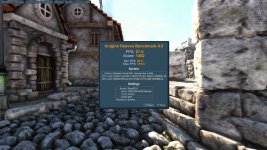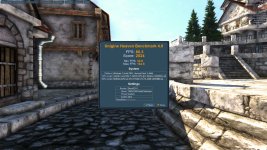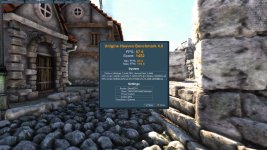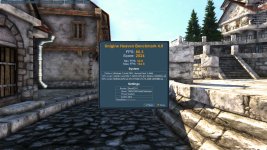-
Competitor rules
Please remember that any mention of competitors, hinting at competitors or offering to provide details of competitors will result in an account suspension. The full rules can be found under the 'Terms and Rules' link in the bottom right corner of your screen. Just don't mention competitors in any way, shape or form and you'll be OK.
You are using an out of date browser. It may not display this or other websites correctly.
You should upgrade or use an alternative browser.
You should upgrade or use an alternative browser.
Is there any truth that AMD cards are bad at Tessellation
- Thread starter Kaapstad
- Start date
More options
Thread starter's postsThe above two sets of tests seem to be a turn up for the books. The Titan seems to lose more performance when running extreme tessellation than the 290X.
If this is true
Are AMD cards really that bad on tessellation ?
Also if it is not the tessellation holding the AMD cards back on the Heaven 4 bench, then what is holding them back ?
Perhaps more people with AMD and NVidia cards can do the same as me with tests for extreme tessellation and tessellation disabled.
If this is true
Are AMD cards really that bad on tessellation ?
Also if it is not the tessellation holding the AMD cards back on the Heaven 4 bench, then what is holding them back ?
Perhaps more people with AMD and NVidia cards can do the same as me with tests for extreme tessellation and tessellation disabled.
Caporegime
What's wrong with your motherboard?
The Nforce2000 chip does not like XDMA bridgeless crossfire, so im getting the same board as you, p8z77 ws. Should be here tuesday.
The Nforce2000 chip does not like XDMA bridgeless crossfire, so im getting the same board as you, p8z77 ws. Should be here tuesday.
What do you recon on the above, by the looks of it my 290X performs better when using tessellation than my Titan.
Even though the Titan is faster the % gap closes when tessellation is turned on.
Just worked out that with the Tessellation on extreme the Titan is 6.14% faster
With the Tessellation turned off the Titan is 9.23% faster
Last edited:
Caporegime
What do you recon on the above, by the looks of it my 290X performs better when using tessellation than my Titan.
Even though the Titan is faster the % gap closes when tessellation is turned on.
Just worked out that with the Tessellation on extreme the Titan is 6.14% faster
With the Tessellation turned off the Titan is 9.23% faster
I'm not sure. I always thought it was to do with tessellation but maybe its not.
I'm not sure. I always thought it was to do with tessellation but maybe its not.
The point is the 290X has made a better job of handling the Tessellation than the Titan.

Caporegime
The point is the 290X has made a better job of handling the Tessellation than the Titan.
Must be something else then i guess. I wonder how things stack up on the older version of Unigine? Maybe its something in this version that just favours GK. In games 290's handle tessellation fine though so i guess it should not come as a major surprise.
Must be something else then i guess. I wonder how things stack up on the older version of Unigine? Maybe its something in this version that just favours GK. In games 290's handle tessellation fine though so i guess it should not come as a major surprise.
I don't know how much tessellation there is in the batman bench but the 290Xs seem to do ok on that as well.
Soldato
Seems Techreport beat me to it with TessMark. There isn't a great deal in it, but Nvidia cards are still the better at it with insane settings. Unigine engine seems to match your tests Kaap 
http://techreport.com/review/25509/amd-radeon-r9-290x-graphics-card-reviewed/6
Does beg the question what is holding the 290s back so much in Heaven

http://techreport.com/review/25509/amd-radeon-r9-290x-graphics-card-reviewed/6
Does beg the question what is holding the 290s back so much in Heaven
Last edited:
Seems Techreport beat me to it with TessMark. There isn't a great deal in it, but Nvidia cards are still the better at it with insane settings. Unigine engine seems to match your tests Kaap
http://techreport.com/review/25509/amd-radeon-r9-290x-graphics-card-reviewed/6
Does beg the question what is holding the 290s back so much in Heaven
I have heard many times that AMD cards are bad at tessellation but this does not seem to be the case, for the Hawaii GPUs anyway.
But yes it does beg the question what is holding the 290s back in heaven.
Soldato
- Joined
- 14 Feb 2011
- Posts
- 7,490
I have heard many times that AMD cards are bad at tessellation but this does not seem to be the case, for the Hawaii GPUs anyway.
But yes it does beg the question what is holding the 290s back in heaven.
Also bear in mind the 7970's used to beat the 680's in said benchmarks.
Soldato
It's a shame there isn't a tessmark for direct3d. I was sure there was one. The insane preset seems to leave AMD cards in the dust under OpenGL  . Albeit some would argue it's not relevant given its not considered relevant lol...
. Albeit some would argue it's not relevant given its not considered relevant lol...
 . Albeit some would argue it's not relevant given its not considered relevant lol...
. Albeit some would argue it's not relevant given its not considered relevant lol...
Last edited:
Is there any truth that AMD cards are bad at Tessellation
Obviously.
Maybe not low levels of tessellation but certainly high levels, which is why NVidia adding excessive amounts of tessellation in some games brought AMD cards to their knees... and why AMD felt the need to add a "tessellation dumber downer" slider and "AMD Optimized" checkbox (pre-dumbed down profiles) into their drivers.
Is it really necessary to test it?

Last edited:
I have heard many times that AMD cards are bad at tessellation but this does not seem to be the case, for the Hawaii GPUs anyway.
But yes it does beg the question what is holding the 290s back in heaven.
Good findings, Kaap. Can I request you to do a similar test with your 290x and Titan at higher clocks as well?
I found AMD cards are lacking in Valley a lot more than in Heaven as well but that need not just be from tesselation.
Soldato
Obviously.
Maybe not low levels of tessellation but certainly high levels, which is why NVidia adding excessive amounts of tessellation
That's the whole point though, are they actually BAD.
As you have stated, Nvidia's hardware seems to cope better with excessive levels of tessellation, but these are silly, as you say, excessive levels, not usage which actually benefits the developer or user in any way, so is that really valid?
Should the question not be, why has Nvidia wasted silicon/time implementing something that is essentially there for no reason other than benchmark rigging?
If as mentioned above, the AMD cards actually take a reduced framerate percentile hit vs a Titan when active at reasonable levels, would that not suggest they are actually 'better'/more effective or efficient at tessellation, they just haven't been designed with silly levels in mind; whereas Nvidia has added this scenario into thier capabilities as a 'joker card'?
Heaven on my 780 at extreme settings overclocked 1215 core and 7200 memory is 1603
overclocked 1215 core and 7200 memory to no tessellation is 2081
Not overclocked, ( 1110 core + 3210 memory ) is 1821
Heaven seems more gimped on nvidia with extreme tessellation than amd.
overclocked 1215 core and 7200 memory to no tessellation is 2081
Not overclocked, ( 1110 core + 3210 memory ) is 1821
Heaven seems more gimped on nvidia with extreme tessellation than amd.
Caporegime
AMD excuses at getting their behinds tanned from nVidia 

Stock Titan @837/1502
3930k @4.7
With extreme tessellation
With tessellation disabled
Increase in FPS 39.39%
The thing that surprises me is that my system seems to be getter a better score than a system with 4x Titans when in fact the Titans should destroy my scores (I only have 2x AMD 7950s). The only difference I can think of is that my system might have a higher overclock on the CPU but that shouldn't make that much difference.
Caporegime
- Joined
- 18 Oct 2002
- Posts
- 33,188
Well at some stage AMD need to bump up tessellation hardware after Nvidia go around paying dev's to over use it, so stupid websites don't mark them down for it. These things go in circles, one company does something utterly retarded to win a pointless benchmark, the other company has to follow or expect Average Joe to understand why Nvidia wins and why it doesn't matter...
There is no bad though, tessellating things you can't see is almost the definition of inefficient and stupid. If Nvidia can produce the same image to the end user with tessellation at (making up numbers for example) level 4 as level 8, but level 8 costs 10 times more the performance for no IQ improvement, what is bad... having better performance vs AMD when both use level 8, or having better performance vs AMD at level 4? This is what always irks me, not that AMD get screwed, but that Nvidia guys happily put up with being screwed by Nvidia... for the sake of someone else's card performing worse. Why should an Nvidia card owner be happy that Crysis 2 ran slower on their own card because a flat surface was being over tessellated... it's mental.
As for why AMD is behind in test X, why is Nvidia behind in test Y. Different tests are written in different engines, different code, different optimisation, different programming style, different experience. Expecting the same code to work as well on different architectures that use the code differently is, well, daft.
Even at the driver level, it's difficult to know if AMD has already enabled their "cull pointless tessellation levels to a sensible amount" behind the scenes. The option is there in drivers, but doesn't mean AMD isn't enabling it by default for a specific test, Nvidia/Intel/AMD have done that for gpu benchmarks for years. So it would be hard to get a clean test, it might be that AMD added a hardware limit for tessellation. Something that simply prevents the gpu running tessellation at stupidly high levels and the software option is there for older hardware.
In such cases it's basically impossible to compare without being directly in contact with AMD and getting such answers.
You could try much older drivers, use the software option and see if that changes anything, try the test on old drivers on older cards.
IE maybe a 6970 gains 40% performance by enabling the software "AMD optimised" tessellation, but a 290x doesn't because it already limits it(through hardware or software).
There is no bad though, tessellating things you can't see is almost the definition of inefficient and stupid. If Nvidia can produce the same image to the end user with tessellation at (making up numbers for example) level 4 as level 8, but level 8 costs 10 times more the performance for no IQ improvement, what is bad... having better performance vs AMD when both use level 8, or having better performance vs AMD at level 4? This is what always irks me, not that AMD get screwed, but that Nvidia guys happily put up with being screwed by Nvidia... for the sake of someone else's card performing worse. Why should an Nvidia card owner be happy that Crysis 2 ran slower on their own card because a flat surface was being over tessellated... it's mental.
As for why AMD is behind in test X, why is Nvidia behind in test Y. Different tests are written in different engines, different code, different optimisation, different programming style, different experience. Expecting the same code to work as well on different architectures that use the code differently is, well, daft.
Even at the driver level, it's difficult to know if AMD has already enabled their "cull pointless tessellation levels to a sensible amount" behind the scenes. The option is there in drivers, but doesn't mean AMD isn't enabling it by default for a specific test, Nvidia/Intel/AMD have done that for gpu benchmarks for years. So it would be hard to get a clean test, it might be that AMD added a hardware limit for tessellation. Something that simply prevents the gpu running tessellation at stupidly high levels and the software option is there for older hardware.
In such cases it's basically impossible to compare without being directly in contact with AMD and getting such answers.
You could try much older drivers, use the software option and see if that changes anything, try the test on old drivers on older cards.
IE maybe a 6970 gains 40% performance by enabling the software "AMD optimised" tessellation, but a 290x doesn't because it already limits it(through hardware or software).
Last edited:
That's the whole point though, are they actually BAD.
They are bad by their competitors standards.
AMD's implementation of optimising for low levels is a short term mentality whereas NVidia are looking to the future.
You hear people banging on about AMD cards being more future proof due to extra VRAM all the time, but when NVidia have GPU's that can do amazing amounts of tessellation it gets downplayed?
Tessellation usage will only increase and eventually those extreme levels will become the norm, NVidia are just ahead of time.
Last edited:





